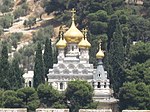Mount of Olives Jewish Cemetery

The Jewish Cemetery on the Mount of Olives is the oldest and most important Jewish cemetery in Jerusalem. The Mount of Olives has been a traditional Hebrew/Jewish burial location since antiquity, and the main present-day cemetery portion is approximately five centuries old, having been first leased from the Jerusalem Islamic Waqf in the sixteenth century. The cemetery contains anywhere between 70,000 and 150,000 tombs, including the tombs of famous figures in early modern Jewish history. It is considered to be the largest and holiest historical (as opposed to modern) Jewish cemetery on earth.It is adjacent to the much older archaeological site known as the Silwan necropolis.
Excerpt from the Wikipedia article Mount of Olives Jewish Cemetery (License: CC BY-SA 3.0, Authors, Images).Mount of Olives Jewish Cemetery
AWEIS, Jerusalem Ras al-Amud
Geographical coordinates (GPS) Address Nearby Places Show on map
Geographical coordinates (GPS)
| Latitude | Longitude |
|---|---|
| N 31.773838888889 ° | E 35.243069444444 ° |
Address
עוויס
AWEIS
9114001 Jerusalem, Ras al-Amud
Jerusalem District, Israel
Open on Google Maps











